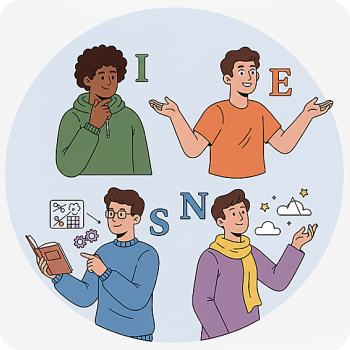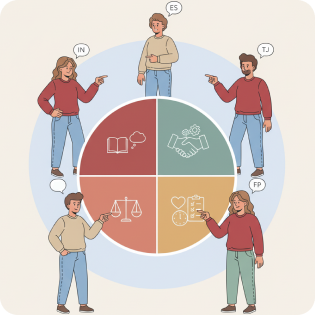
The Core Concepts of the MBTI Personality Test
The MBTI, also known as the personality test by Myers-Briggs, operates under the core belief that variations in personality can be systematically categorized. This personality assessment tool relies on four key dichotomies: Extraversion vs. Introversion, Sensing vs. Intuition, Thinking vs. Feeling, and Judging vs. Perceiving. Each dichotomy in this unique personality model offers insight into different facets of individual personality, thus facilitating a deeper comprehension of their inherent preferences.

Derived from these dichotomies are the MBTI personality types test, which categorize a person's preferences into one of the 16 distinct types. Each type is represented by a four-letter code, such as ISTJ or ENFP, which denotes their particular combination of preferences. This unique approach allows individuals to gain a deeper understanding of themselves and others, facilitating improved communication and interpersonal relationships.
Understand Yourself in 16 Personality Types
The Myers-Briggs Type Indicator test, commonly known as the MBTI test, is a widely recognized tool for understanding personality. Developed by Katharine Cook Briggs and her daughter Isabel Briggs Myers, this test is based on Carl Jung's theory of psychological types. It categorizes individuals into 16 distinct personality types, providing valuable insights into how people process information and make decisions.

The Structure of the MBTI Personality Type Test
One intriguing aspect of the 16 personalities MBTI is how it categorizes people into meaningful groups. These groups help pinpoint how different personalities interact with the world around them. An individual might be high on extraversion but low on sensing, which would give insights into their communication style and problem-solving approach. Here's a simple table breaking down each dimension and its contrasts:
| Dimension | Preferences |
|---|---|
| Focus of Attention | Extraversion (E) vs. Introversion (I) |
| Information Processing | Sensing (S) vs. Intuition (N) |
| Decision Making | Thinking (T) vs. Feeling (F) |
| Lifestyle Orientation | Judging (J) vs. Perceiving (P) |
This division of personality traits provides a more nuanced view of human behavior than many other tests. It is why the Myers-Briggs personality types test remains popular among psychologists and career counselors alike.
MBTI Test Benefits
Individuals who engage with the personality test MBTI often find it beneficial in various aspects of their lives. By understanding their specific MBTI personality test result, individuals can learn about their strengths and areas where they may wish to improve. Moreover, when working in teams, knowledge of the Myers-Briggs Type Indicator (MBTI) personality test can improve team dynamics.

Taking the Myers-Briggs Personality Type Test Online
In today's digital age, accessing the MBTI personality test online has become convenient. Numerous platforms offer the test, allowing individuals to quickly gain insights into their personality types. These online tests are designed to be user-friendly and often provide comprehensive reports that detail an individual's type and preferences.

Such platforms cater to various audiences, from those seeking casual insights into their personalities to professionals who rely on MBTI results for career development purposes. The accessibility of the Myers-Briggs Type Indicator (MBTI) test online means that everyone can benefit from this powerful tool without the need for in-person appointments.
Closing Remarks
In conclusion, the Myers-Briggs Type Indicator (MBTI) test remains a valuable tool for anyone looking to deepen their understanding of themselves or others. By offering insights into the diverse ways people think, feel, and behave, it continues to foster better self-awareness and interpersonal harmony.
Frequently Asked Questions
The Latest News



Please Note
This website (mbtitest.us) is not an official representative, creator or developer of this application, or product. All the copyrighted materials belong to their respective owners. All the content on this website is used for educational and informative purposes only.
